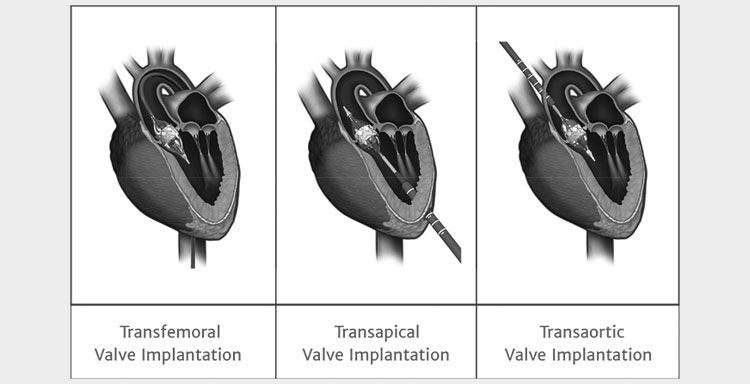
TAVI / TAVR / PAVR
Catheter based, transcatheter aortic valve replacement (TAVR), also known as transcatheter aortic valve implantation (TAVI). The replacement valve is delivered via one of several access methods like, a) transfemoral (in the upper leg), b) transapical (through the wall of the heart), c) subclavian (beneath the collar bone), d) direct aortic (through a minimally invasive surgical incision into the aorta), and d) transcaval (from a temporary hole in the aorta near the belly button through a vein in the upper leg). Severe symptomatic aortic stenosis carries a poor prognosis. Until recently, surgical aortic valve replacement has been the standard of care in adults with severe symptomatic aortic stenosis. However, the risks associated with surgical aortic valve replacement are increased in elderly patients and those with concomitant severe systolic heart failure or coronary artery disease, as well as in people with comorbidities such as cerebrovascular and peripheral arterial disease, chronic kidney disease, and chronic respiratory dysfunction specially in octogenarian patients.
TAVI (Transcatheter Aortic Valve Implantation) procedure is a minimally invasive procedure that replaces the aortic valve in the heart. Aortic valve stenosis, also known as aortic stenosis, occurs when the aortic valve narrows. This narrowing prevents the valve from opening fully, which reduces or blocks blood flow from your heart to the rest of your body via the main artery (aorta). Symptoms include breathlessness, chest pain, black-outs or heart failure.
In certain circumstances, procedures or surgery to either repair or replace the valve may be prescribed as treatment options for aortic stenosis. TAVI involves a new valve being inserted without the need for open heart surgery. It may be suitable for people who are high risk for conventional surgical replacement and with heart team decision.
One day stay and procedure done under local anaesthetic and next day discharge
It's life saving procedure
Two year death rate is 50% in patients severe aortic stenosis with symptoms angina, syncope and breathlessness

